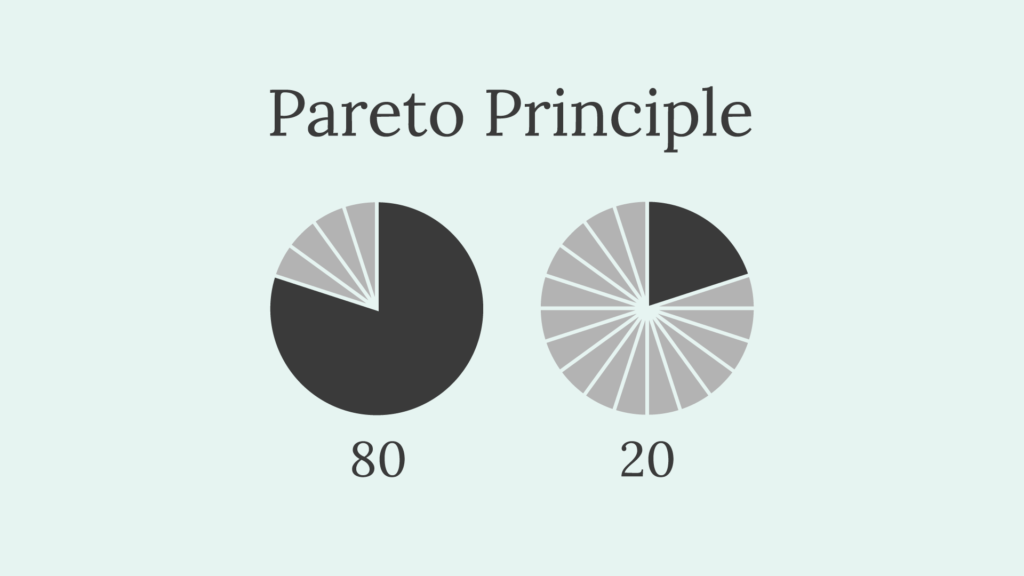|
Getting your Trinity Audio player ready...
|
Have you ever heard the term '80/20 rule' before? If not, then you should definitely take a look at this article because it might change your life forever. The 80/20 rule is a simple concept that helps us achieve success in our lives.
It's an extremely helpful tool for making decisions and achieving goals. The 80/20 rule can help business owners become successful faster by focusing on the right things. It's a very powerful idea that has helped many great entrepreneurs make their dreams come true.
So what exactly is the 80/20 rule? Well, it's quite simply explained as "the law of least effort". This means that if we have two choices with different outcomes, most likely one will be better than the other. But which option would you choose? More often than not, people tend to go for the more appealing.

What is the Pareto Rule?
The 80-20 rule is also known as the Pareto principle. The Pareto Principle is an economic principle which says that for many events or processes, roughly 80% of effects come from only 20% of causes. This means that if you want to change something, you should first figure out what the biggest contributor to the problem is and then work on fixing that thing.
This principle has been applied to many different fields including economics, business, politics, sports, and even personal development. The idea behind the Pareto principle is that there is an optimal amount of effort required to achieve a certain result.
How Does that Work?
The 80/20 rule is a simple concept that helps us understand how we should best focus our efforts, in our everyday lives. We can apply it to almost every aspect of life.
For example, let's say you're working on your career. You may learn that you spend 80% of your time doing administrative tasks at work and 20% of your time working on high-value tasks or projects. You could then ask yourself whether you'd like to spend more time on your projects or on your admin tasks.
Another example might be your fitness routine. You may notice that you spend 80% on cardio exercises and 20% on strength training. You could then choose to spend more time on strength training or less time on cardio.
The 80 / 20 Rule is a simple yet effective strategy for efficiency in many areas of life. By applying the 80/20 rule to your daily activities, you will see a noticeable improvement in your productivity.
You should focus on the top 20% of what you do while leaving the rest for later. If you apply this rule correctly, you will achieve great results.
The Pareto Principle can be Misunderstood
The 80/20 Rule is a principle, not a law. It doesn't say anything about what should happen when you add all the numbers. So, the fact that 80% and 20%, added together, equals 100% is just a coincidence.
But it's still true. If you add up all the numbers in your bank account, there will probably be more money in the top 20% than in the bottom 80%. And if you add up all the words in an English dictionary, there will probably be fewer than 200,000 words in the top 20%.
The 80-20 rule is not always understood correctly. In some cases, the misunderstanding may stem from a logical fallacy—namely, that if 20% of inputs are most important then the other 80% must not be important. At other times, confusion arises because of the coincidence of the 100% sum.
This rule states that 20% of your customers account for 80% of your revenue. If you're not focusing on them, you're probably wasting time and money on other customers. You should figure out what type of customer each of your products and services attract and focus on providing the best service to those customers.
Applying the Rule to Business
In business, the 80/20 rule states that 80% of your results come from 20% of your activities. So, if you spend 80% of your time on 20% of your customers, you will get 80% of your results.
- If you apply this to marketing, you could say that 20% of your customers generate 80% of your revenue. You should therefore focus all your efforts on those customers.
- If you are a freelance writer, you may not realize just how important your top 20% of clients are. These are the clients who pay you the highest rates and also provide you with the best opportunities. If you are not working with them, you will never earn what you deserve. So, when you start getting overwhelmed, you can put your energy towards focusing on your top 20%. You can always get back to the rest later.
It's not just about what you're doing, but how you're doing it. When you focus on the big picture, you can zoom out and see your overall strategy. When you apply the 80/20 rule to daily tasks, you'll get a clearer view of what matters.
You'll understand why you should spend time on certain activities and delegate to others. And you'll gain insight into how you can streamline processes and save money.
How can You Apply the Rule to Gain more Time?
The 80 / 20 Rule is an easy way to understand what you need to do to get the best results in your personal life. You first figure out what 20% of your activities bring 80% of your results.
You can also think about what you need and what you want. I'm sure there are things in your life that you would like to change, but you don't know where to start. The 80/20 rule can help you identify what you to focus on first.
You can always get rid of what doesn't serve you and prioritize key tasks. By doing this, you will see what you should be focusing on. There are many ways to apply the 80/20 principle to your own life. Here are some :
- You can unsubscribe to 80% of the emails you receive because you rarely read them anyway.
- You can give away the rest of your clothes because you never wear them.
- And you can delete the apps you don't need on your smartphone.
- You might want to focus on spending quality time with friends or family instead of watching TV. Or you might decide to stop going to parties and clubs so you have more time to pursue your hobbies.
- If you find out that 80% of your users use only 20% of your product features, then you might consider prioritizing those specific features.
Steps to Apply the Rule
Identify what you need to get done every day. Prioritize those tasks. What gives you the most return? Which action items will bring you the most value? How can you cut down on the time spent doing other things? Use 80/20 to identify the best high-value tasks to focus on first.
Set goals you want to achieve. Focus your time and energy on those goals. If you're not sure what you should be doing, ask yourself why you're doing something. Is there a reason? What will happen if you stop doing it? Will it help you reach your goal? If not, then maybe it isn't worth doing.
Benefits of The Pareto Principle
- It helps you prioritize your work.
- It provides clarity for allocating resources.
- It helps you make decisions based on priorities.
- It helps eliminate distractions from your daily routine.
- It helps reduce stress and anxiety.
- It helps increase productivity.
- It helps improve relationships.
- It helps create balance in your life.
- It helps manage your time effectively
Key Takeaway
The Pareto principle or 80/20 rule has been around for a long time, and its basic applications are numerous. You can use it when focusing on your skills, target market or customers. It will help you improve profitability, find the fastest way to reach your business goals, and reduce your workload.
In your personal life, it can improve your productivity and efficiency. You'll also enjoy the benefits of focusing on the big picture instead of being distracted by minor details.
It's no wonder that it's still studied today, more than two centuries after it was first introduced. There is a strong argument to be made that the Pareto principle as we know it today is as true now as it was back then.
It doesn't take much digging to find examples of this principle in effect in our daily lives. And if you're looking for simple ways to apply this principle to your life, you'll find plenty of options in the world of business.



